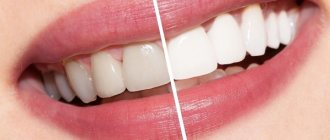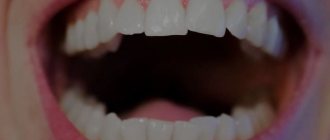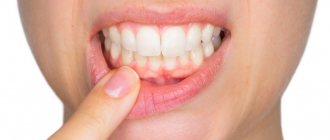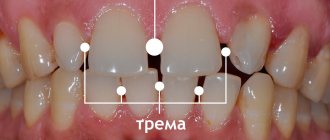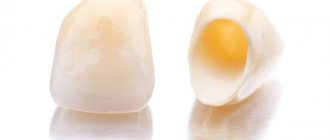Are your teeth too close together? Does this result in the formation of a dental arch shortened by several millimeters? Does this affect facial symmetry? Most likely, we are talking about crowded teeth. The problem lends itself to an effective orthodontic solution. If treatment is approached comprehensively, then in a few months the defect can be removed and you can boast of your beautiful and healthy teeth. What exactly should you pay attention to when treating dental crowding? Experts spoke about this.
What is crowded teeth in children and adults, and why does it occur?
Crowding of teeth is a common problem in which the dental units are located too close to each other, some crowns “overlap” the bottoms of the neighboring ones, forming an unaesthetic picture.
Teeth can be crowded in the middle, on the sides, and also in both the back and frontal areas at the same time. Most often, dentists diagnose crowding of the front teeth of the lower jaw.
There are three stages of dental crowding:
- Third or advanced, when the dental arch decreases in size by approximately 7 millimeters;
- The middle stage of dental crowding, when the row of teeth is shortened by 4 - 6 millimeters;
- Initial or first, when the size of the dental arch is reduced by 2 - 3 millimeters.
Forecast. Prevention
When treating crowded teeth syndrome, the prognosis is favorable in most cases. Thanks to the use of modern therapeutic methods, it is possible to restore the aesthetic appearance and functionality of the maxillofacial apparatus. The prognosis for restoration of the gums and maxillofacial area directly depends on the degree of development of crowding and the timeliness of contacting a specialist.
Depending on the degree of development of the patient’s pathology, the duration of full treatment ranges from 1.5 to 3 years.
If left untreated, plaque and tartar appear, and gingivitis, caries, and various periodontal diseases may develop. This leads to premature tooth loss.
The best method of prevention is a systematic visit to the dentist. The doctor at the appointment will help to timely identify negative factors, predisposition to anomalies and take measures to reduce negative consequences.
Why do some people experience crowded teeth while others do not have the problem?
There are many reasons for crowded teeth. Let's list the most common ones:
- anatomically large teeth;
- large jaw from birth;
- “extra” teeth;
- wisdom teeth that were recommended to be removed, but were not removed after eruption;
- “bad habits” in young patients (thumb sucking, pacifiers, artificial feeding);
- breathing through the mouth, caused by ENT diseases, scoliosis, and other factors. Against the background of oral breathing, the child’s dental system is formed incorrectly;
- lack of minerals and vitamins necessary for the formation of healthy teeth;
- early removal or loss of baby teeth (for example, due to mechanical trauma).
Let's smile together!
I want to tell you about such an important factor in treatment as emotions. If the attending physician, as a rule, always directs emotions in a positive direction, since correcting the patient’s bite is his profession, then for the patient, every moment of improvement in his current condition, or vice versa, every small anxious moment is a surge of emotions. That's right, because the patient begins a new life with a beautiful smile, and for him in this new life there is already a place for openness and positive impressions.
During treatment with aligners, as agreed, the patient very actively communicated with me using messengers.
Crowding of a number of teeth in a child - how to spot it in time and how to help?
Children's crowding of teeth, as a rule, occurs and is noticeable even at the stage of eruption of baby teeth. In the period from 4 to 6 years, when increased growth of the jaws occurs, a space (the so-called trema) is formed between the baby teeth, which is necessary for the eruption of permanent teeth. If the space does not form, it means that the eruption of the molars will be late, or there are other problems with the jaw.
It is important! During the period of eruption of molars, it is important to check the ENT organs and correct existing problems with posture, since these points are interrelated. Against the background of mouth breathing (and correct breathing through the nose), defects of the bite and jaw are formed, including crowding of teeth.
When diagnosing a tendency to crowding of teeth or true crowding of a row, the orthodontist recommends step-by-step treatment:
- wearing myofunctional trainers that will correct the position of the jaws and help align the dentition at the teething stage;
- myofunctional gymnastics exercises, which will help “pump up” the chewing and facial muscles, normalize muscle tone in this area;
- the use of corrective elements for teeth and jaws: plates, dental activators, palatal expanders, etc.
If crowded teeth are diagnosed in a teenager between the ages of 13 and 16, dentists may recommend the use of braces or aligners. In advanced cases, ligature braces are recommended.
Causes
Small jaw. First of all, bad childhood habits and developmental features affect them: infantile type of swallowing, mouth breathing, prolonged sucking of a pacifier or bottle, poor nutrition, predominance of soft foods, lack of chewing load. Also, underdevelopment of the jaw bone can be caused by the early loss of baby teeth and the long absence of permanent teeth in their place, heredity, and intrauterine disorders.
Narrowing of the dental arches. It occurs due to soft tissue dysfunction, which, in turn, can be caused by hormonal disorders, injuries, metabolic disorders, heredity, or malocclusion.
Too rapid change of teeth (up to 6-7 years). The jaw bones cannot keep up with the growth of permanent teeth, so they do not have enough space. It is not known for certain why in some children the replacement of baby teeth with molars occurs earlier than expected. This feature is due to individual anomalies in the formation and eruption of teeth.
Pathological growth of teeth. “Eights”, or third molars, erupt quite late, at 16-27 years old, and they often no longer have enough space. As they grow, they move adjacent molars and push the entire row, which can cause crowding of teeth. Other provoking factors are hyperdentia, or supernumerary, extra teeth, and macrodentia - an increase in the size of one or more teeth.
Can crowded teeth develop after wisdom teeth erupt?
Yes maybe. This is a fairly common picture when a person had relatively straight teeth up to a certain stage, but after the third molars came out, pronounced crowding began to be observed.
Crowding occurs as a result of the pressure of the wisdom tooth on the remaining teeth, the row moves, healthy teeth “find” each other, which is why they deteriorate.
The situation is aggravated if wisdom teeth come out on both the left and the right at the same time.
Crowding of the dentition can be observed even if there is room in the jaw for a wisdom tooth, and, moreover, it is inevitable if the “eights” are located abnormally.
To solve the problem of crowded units, wisdom teeth are recommended for removal. It is also better to remove the “eights” if the x-ray shows their incorrect position. These measures are recommended as prevention.
Recommendations for using braces
Although braces can correct even severe crowding, it will take time and repeated visits to a specialist. In addition, the patient needs to change eating habits and pay more attention to oral hygiene.
- Brush your teeth under the orthodontic product. Orthodontists have developed a number of recommendations, compliance with which will make using the device more comfortable:
- Brushing your teeth after every meal is mandatory. The optimal solution would be to purchase a professional toothbrush, in addition to using dental floss and an interdental brush.
- Avoiding seeds and nuts while wearing braces. Particulate matter can damage the structure, resulting in the need for replacement. Care should be taken when handling any solid food: raw vegetables, fruits, meat fibers. It is not recommended to chew them - it is better to cut them into small pieces and chew them thoroughly.
- Excluding viscous products from the menu (caramel, nougat, chewing gum). They clog the grooves in the shoulder straps and are almost impossible to clean.
- Reasonable consumption of hot and cold drinks. A sharp change in temperature leads to thermal expansion of the metal elements, as a result of which the braces can peel off from the enamel.
- Regular visits to a specialist and immediate contact with him in the event of damage to the structure.
Additionally, caution should be exercised when consuming coloring foods and beverages while treating crowding. Coffee, strong tea, and soda can stain the transparent elements of the braces system and make it more noticeable.
After fixing the device, the patient may experience discomfort and pain in the jaw area during the first two weeks. Such manifestations are natural and should not cause concern. Over time, the discomfort disappears, and the bandage becomes familiar.
Modern designs are made from the most delicate materials, but soft tissue injuries may occur during installation. In order not to damage the gums, it is necessary to use plastic wax, provided in time by a specialist. If the mucous membrane is still red and swollen, it is recommended to use anti-inflammatory drugs until the wound is completely healed.
Can teeth crowding be treated with aligners?
Yes, such treatment is in demand. Aligners are aligners, a removable orthodontic device made of polycarbonate. A more aesthetic, but at the same time expensive alternative to braces. Aligners exert constant pressure on crowded teeth, provoking the natural resorption of alveolar bone tissue in the direction of tooth movement, while bone tissue is formed in the opposite direction. Thus, the crowded teeth move along a trajectory pre-planned by the orthodontist, and the crowding gradually goes away. Dental aligners are distinguished by their aesthetic appearance, compact size, easy to remove and put on, invisible on the teeth, and easy to care for throughout the entire treatment period.
Correction of dental defects
Correction with braces. The main problem when installing braces for an adult is that his jaw is already fully formed. Sometimes, when getting braces, several teeth need to be removed.
Modern dentistry offers several options for fixed structures:
- Metal braces that quickly correct dental defects.
- Plastic braces are less noticeable, but they can be stained by food and break fairly quickly.
- Ceramic and sapphire braces have a beautiful appearance and withstand physical activity quite well, but the braces are very expensive.
Many patients are concerned about the aesthetic impression they will make on others when they appear with braces on their teeth. Such patients are offered structures that are installed on the teeth from the tongue side, so they become invisible to prying eyes.
Correcting crowded teeth with braces takes quite a long time (about a year), but here the patient has to sacrifice aesthetics and choose health benefits.
Can crowded teeth be treated without braces?
Yes, treatment without braces is acceptable. If the patient does not want to get braces, or there are objective medical reasons for this, it is recommended to treat the defect using tooth separation. The lateral interdental areas are lightly ground at each edge. As a result, it is possible to obtain the previously missing three millimeters to straighten the dentition. Also, if teeth are slightly crowded, specialists may suggest installing veneers or lumineers. Dentists specialize in treating crowded teeth with braces, aligners, and other effective techniques. An integrated approach to solving the problem, maximum preservation of the health of your teeth, ideal results in a short period of treatment. Schedule a consultation today to enjoy a healthy, beautiful smile in no time.
Treatment methods for crooked teeth
Modern orthodontic designs can successfully treat crowding. Based on the characteristics of the clinical picture of the pathology, one or another correction procedure may be indicated.
Braces
Most often, such treatment is justified if the pathology is not too serious. The course of correcting the defect will take several months; if you follow all the specialist’s recommendations, the effect of treatment is noticeable and lasting. For each patient, the time for using the systems is selected individually - it depends on the age group, the quality of the periodontal tissues and the presence of concomitant diagnoses. Various models of such structures allow you to align the jaw row due to the formation of an oval of the correct shape formed by an arch. Thus, abnormally overgrown organs end up in the right place.
Removal of a tooth
If there is insufficient free space in the row of the lower jaw, especially in the stage of a developed type of crowding, the patient has no choice but to resort to the removal of part of the organs. First, the outermost lateral teeth, also called wisdom teeth, are amputated. If the clinical situation is too advanced, sometimes even such a radical measure is not enough and the premolars must be removed. This mainly affects the lower jaw, since it is much more susceptible to deformation and mechanical stress than the upper jaw. Due to this, its natural size becomes a little smaller over time, and with such a diagnosis this is quite an aggravating factor. Depending on the severity of the disease, the course of treatment can range from 2-3 weeks to 1.5-2 months. After removal of all necessary organs, the installation of orthodontic structures is indicated. The cost of the removal procedure is standard and depends on the region, clinic and the cost of pain medication.
Extension
Such treatment will be effective only if the pathology is not very pronounced. It is carried out by lightly smoothing the enamel surface (mechanical separation principle) or installing spacers (physiological separation option). The first case is the opportunity to free up to 0.5 cm of the interdental space. It should be noted that many experts consider separation to be a fairly worthy alternative to amputation of jaw fragments. The procedure is carried out quickly, sometimes 2-3 visits to the dentist are enough.
Leveling devices are used for initial and moderate severity of anomalies.
- Aligners.
With the help of aligners, treatment proceeds much slower (within 1 year), but this procedure is much more comfortable for the person. The cost of structures is several times more expensive than braces, but the effectiveness of such treatment is much higher.
The principle of crowding relief is to apply light but constant pressure to the row of jaws. With the help of the habituation reflex, organ fragments are transferred to the correct position. There is a psychological “memorization” of the teeth in the desired position, which develops during the treatment process and is gradually corrected with each subsequent removable aligner. They are transparent and thin in appearance and are not difficult to wear. The course of treatment is about a year. Their cost is determined by the complexity of the correction and the number of aligners performed.
- Expansion of the dentition using plates.
Such manipulations are allowed only after a thorough study of the qualitative condition of periodontal tissues. The doctor records the presence of the amount of hard bone required for the procedure. The manipulation itself is carried out in several ways, but plates are often used. The effect is achieved due to the systematic pressure of the expansion plate on a number of jaws and gradually giving its fragments the correct position. Products are made individually. The best results in this case are observed in children and adolescents, whose bones are not yet fully formed and are more susceptible to changes in position than adults. Standard design: metal plate, mounting screws and spring. The devices are secured with clips. The course of treatment depends on the situation. Typically this is a period of 6 to 12 months.
Diagnostics
Diagnosis of crowded teeth includes the following steps:
- visual inspection;
- X-ray diagnostics or orthopantomogram.
Additional diagnostic methods may be used:
- Pon's method - determining the width of the dentition.
- Corkhouse method - measuring the distance between the width of the incisors and the length of the frontal section.
- Snagina's method involves measuring the width of the crown, dental arch, and a line passing along the level of the apexes of the roots of the teeth (apical base).
Advantages and disadvantages of aesthetic correction
In terms of price, aesthetic dental restoration in Moscow may not be the cheapest pleasure. But on the other hand, veneers are quickly made and installed quite simply, while braces need to be worn for a long time, and after treatment is completed, you continue to use a removable orthodontic structure and retainers so that the teeth do not return to their previous position. In addition, those around you who are unaware of the intricacies of treatment will never notice that the teeth have been corrected with veneers. But the installed braces system cannot always be hidden from prying eyes.
However, this method also has disadvantages.
- The more the teeth are rotated around the axis, the more tissue will have to be ground off to install ceramic plates. Sometimes it is necessary to perform large-scale preparation, which increases the risk of damage to the pulp.
- When using veneers, it is quite difficult to perfectly match them to the natural tone of the ground tooth. Tooth enamel and the different layers of underlying dentin have different shades and varying degrees of transparency. They will noticeably affect the aesthetics of the tooth restored with a translucent plate, and a professional will easily notice the “substitution”.
Is it possible to fix teeth without braces?
Yes, but remember that veneers have a limited lifespan and will likely need to be replaced in the future.
Stages
The pathology has three stages of progression:
- simple - the error within a single part of the jaw is no more than 3 mm;
- medium – the size of the deviation is much larger and reaches 6 mm;
- strong - over 7 mm, which is considered an advanced state of the structure of the jaw row.
The phenomenon can be characteristic of one jaw or its fragment, or of the entire dentition.
What is a mesial bite, what methods are used to correct the defect in adults and children?
Come here and read reviews about Clarity ceramic braces, as well as a lot of useful information about the systems.
At this address https://orto-info.ru/zubocheliustnye-anomalii/okklyuzii/otkryityj-prikus.html we will talk about the treatment of open bite in children.
Comparison of aligners and braces
| Braces | Mouthguards | |
| Predicting the result of the adjustment | Approximate planning taking into account dental mechanics | The patient sees the exact result at the 3D planning stage |
| Aesthetics | Noticeable when talking, smiling (except for lingual models) | Invisible to others even close up (face-to-face) |
| Removable\non-removable | Only an orthodontist can install and remove braces. | The patient removes and installs the corrector himself |
| Comfort | The design of locks, clamps, additional elements can injure the mucous membrane, impair sound pronunciation during the adaptation period, there are dietary restrictions | Invisible, flexible, lightweight biopolymer devices, do not affect diction, do not require a change in diet, and are easy to maintain |
| Enamel injury | Under the locks, demineralization is common, the accumulation of bacterial plaque under the tension arc, between the locks contributes to caries | Does not injure the enamel layer or soft tissues; plaque from the surface is easily removed with a regular toothbrush |
| How often should you visit the orthodontist? | To activate ligature devices, a doctor is visited every 3-4 weeks, self-ligating devices - every 2-2.5 months. | every 2-3 months |
What is the difference between braces and aligners?
Both correctors are designed for the same task: they correct occlusion and make the dentition straight. The principle of operation of the structures is identical - moving dental units to a given point, but the similarity ends there.
- The bracket system acts on the dentition using locks and a tension arc, and the aligners create an impulse to shift the tooth with special activators.
- Braces are a non-removable system that is installed for the entire course of treatment, aligners are removable devices that the patient can remove and install independently.
- Orthodontic aligners do not interfere with your usual lifestyle and diet; when using braces, there are certain dietary restrictions.
- Maintaining the hygiene of biopolymer aligners is easier than cleaning a bracket system consisting of many elements.
- Elements of braces can injure the mucous membrane and interfere with closure; the functions of the tongue, created from elastic inert thermoplastic aligners, do not have these disadvantages.
- Locks with an arc are conspicuous (except for lingual systems); mouthguards made of transparent material are almost impossible to see from the outside.
When choosing aligners or braces to straighten your teeth, it is impossible to say for sure which will be better. Not in every clinical situation, mouth guards are the most effective, but they undoubtedly lead in terms of comfort. For each situation, the dentist will offer several treatment options, and the patient will choose the optimal one in terms of price, aesthetics and functionality.



